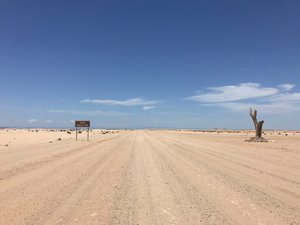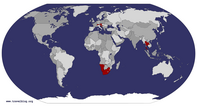Advertisement
Published: February 4th 2021

 Crossing Dorob desert
Crossing Dorob desert
for the Atlantic OceanAfter two days we left the Spitzkoppe Lodge with its unique setting amidst boulders and sand, heading for the Atlantic Coast. Passing the desert of the Dorob National Park we thought for a minute to be in Arabia. The sand structure changed from red into the commonly known yellowish tint. The shape of the dunes reminded us of our Arabic Emirates excursion, we had in 2018. Dorob, means 'dry land', which indeed it is. Nothing this time, really nothing, grows here. No more acacia trees, no more welwitschia flower bushes. The park was established in 1975 and covers over 100'000 km2. It includes also the wetlands of the Atlantic coast, the habitat of numerous bird species, including flamingos and pelicans. This stretch of coast is also famous for seal colonies and dolphins. One of our objectives is to see these flamingos and pelicans, kayak among the seals and hopefully encounter curious dolphins. Our accommodation is right at the coast, overlooking flamingos as they feed, wade through the wet and fly, and is called, what else than, Flamingo Villas Boutique Hotel. The area is for locals a liked tourist spot. Here they can come from their inland farms and mines, dust off
and catch some fresh air. Historically Swakopmund and Walvis Bay played a significant role in the colonialisation of Namibia and as stop over points for ships sailing from Europe to the Cape and further to Asia.
But before we reached our destination we stopped in Hentiesbaai and Cape Cross. The Portuguese navigator and explorer Diogo Cão established in Cape Cross an outpost (padrão) as he mapped out the route to the 'spice islands', ordered by his king. A padrão is a cross made of stone used primarily as navigational help. It is believed that he was the first European to visit this area. This was two years before Bartholomeu Dias successfully rounded the Cape of Good Hope as the first European explorer in 1488. The original cross was removed in 1893 by Corvette captain Gottlieb Becker, commander of the SMS Falke of the German Navy, and taken to Berlin, where it is on display in the 'Deutsches Historisches Museum'.
The other thing to see in Cape Cross is its seal colony. Approximately 100'000 animals live cramped in this bay. The topography does not allow the ocean tides to clean regularly the ground. The stench therefore is revolting, the
noise numbing. Dead baby seals strewn around their bodies decomposing. The aggressive behavior of males further increased by the lack of space, all this leading to a pitiful visiting experience. We very soon were fleeing the scene, trying to get rid of this awful smell in our car and air-condition system.
The coast north of Swakopmund is famous for salt making facilities, and off shore and on shore big game hobby fishing. Everywhere we encountered guys with four wheel drive vehicles (so they can drive onto the sandy beach as close to the water as possible) and their long fishing rods. Passing a desalination facility established for the Swakopmund area, reminded us that we are in a desert and water management is extremely important. After six days of gravel and off road driving we touched asphalt again ! Big yellowish dunes stretch between Swakopmund and Warvis Bay, our destination. Especially on dune no 7 one can fool around; quad biking, sand surfing, dune hiking and camel rides all available for leisure seekers.
Today Swakopmund is primarily a beach resort (although the beaches are not very appealing, and the Atlantic cold) and an example of German colonial architecture. It


was founded by Captain Curt von François in 1892 as the main harbor for the Imperial German colony "South West Africa". The natural deep sea harbor at Walvis Bay situated app 50km to the South, belonged to the British. The founding date was on August 8, when the crew of gunboat Hyäne erected two beacons on the shore. It became the main port for goods, settlers and troops (Schutztruppe) from Germany. To accommodate the unsuitable shore topography a jetty had to be erected where ships could dock. A stroll on it is still possible today, although it is decommissioned as a port. German influences remained evident until today, including German street names, a German daily newspaper, and the German language being spoken by many residents. A 2008 New York Times article describes the town as having the dislocating feel of a Baltic Sea town set in the tropics. Nui and Nenad strolled downtown on a Saturday afternoon and heard only the German language, from the other pedestrians, the sales people in the shops and the waiters in the restaurants. But no tourists to be seen. Connecting with the locals in their lingo, Nenad realised how deep rooted this Germanic culture
and lifestyle truly is here. The town received its name because it lies at the river-mouth of the Swakop river. Needless to say we had lunch in a Bavarian restaurant called Fachwerk Biergarten.
Walvis Bay, the town where we stayed, was first secured by the Portuguese, but later taken by force by the British, who integrated it into the Cape Colony. Only briefly it changed hands when the German troops overran it in 1911, but lost it again in 1915. Its name is Afrikaans and means Whale Bay, indicating the past whale fishing heritage. With its large bay and sand dunes, it is also, like Swakopmund, an important center of tourism in Namibia. In addition to tourism however, Walvis Bay has a fishing industry, a commercial harbor and is a logistics hub, all important for Namibia's economy today. Nui was eager to have her flirt with the flamingos. We dropped our bags in the hotel and went for a walk along Esplanade Road, the coastal road separating our accommodation from the flat, muddy beach. We observed the flamingos peacefully feeding in the setting sun, as we walked alongside their swampy ground. Long slim legs and an elegant body of

 Seal Colony
Seal Colony
100'000 animals crampedwhite and pink. They did not let you come to close. Thus sit down and patiently wait and observe for them to move nearer. Many nice guest houses are to be found along this esplanade, with NO!!! guests (here we go again). Dinner was at 'The Anchor' at the Jetty in Walvis Bay, recommended to us and recommendable by us. Fresh sea food and especially fish, a nice change to the meat braai in the desert we had in recent days. Corona left it's trace on Namibia as well. As we were totally disconnected from the urban areas for a while, we had to learn that in the meantime the Government imposed a curfew at 21:00. All restaurants had to close by 20:00. So it was an early night, we did not mind, as our trip started to slowly wear us down, and we felt quite tired.
Next day, time to reconfirm our trip back to Switzerland. This time no dramas. We needed a Covid test in order to leave Namibia. The connecting flight in Johannesburg from Swiss had no if's and but's, so it looked all good. The climate in the Walvis Bay / Swakopmund area is very


special, hot and cold can change rapidly depending from where the wind is blowing. And the wind can be at times strong. Fog, rain, sun all can change quickly. And the atmosphere is more humid as well than in the desert further inland. It reminded us what the folks in Cape Town are saying; "if you don't like the weather, wait 10 minutes, it will change". Far off shore in the lagoon we observed many oil exploration platforms. No, they were not producing oil, but were decommissioned, parked units, not in use at present. The shallow protected bay was ideal and the money the Namibian Government wanted was little; so the oil companies took advantage. The engineers, maintaining the idle asset are air-lifted on and off the platform and some of them stayed in our hotel exchanging their stories over breakfast.
Driving to the Pelican Point was fun. It took 40 minutes off road driving through flat, sandy beaches to get to the point where we will push the kayaks into the ocean. We kayaked amidst a very large colony of seals, who curiously were swimming around our boat jumping and splashing; sometimes too close for Nui's comfort. In


contrast to Cape Cross, this colony had space, and the beach was flat allowing the tides to clean the sand. So the 60'000 seals here were considerably less noisy, smelly and aggressive. Dolphins were in the bay. We saw them from a distance only. They were too busy hunting, swimming after the fish and have little interest in us. It can happen that they do come close to have some fun. The last point of call for us was the pelican colony, best visited early evening when it is dinner time, and best where fisherman clean their catch of the day. On the way back to the hotel it was necessary to check tires, oil, water and fuel up. We will have a 350km gravel road drive tomorrow into the heart of the Namib Desert. So our Ford Ranger better be ready, and our drinking water in the car sufficient.
Advertisement
Tot: 0.119s; Tpl: 0.013s; cc: 12; qc: 45; dbt: 0.0838s; 1; m:domysql w:travelblog (10.17.0.13); sld: 1;
; mem: 1.2mb





















